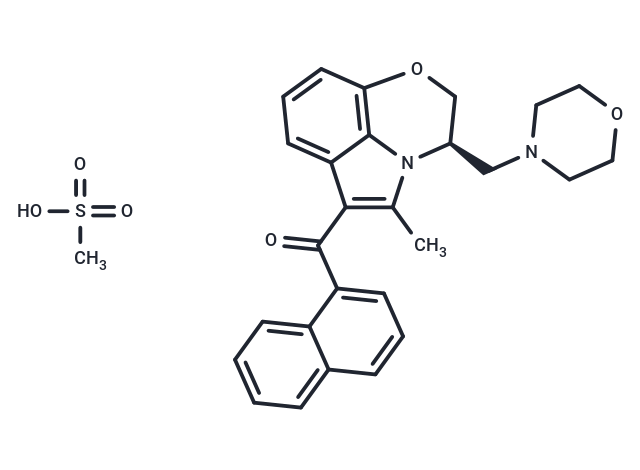Shopping Cart
- Remove All
 Your shopping cart is currently empty
Your shopping cart is currently empty

WIN 55,212-2 Mesylate ((R)-(+)-WIN 55212) is a potent aminoalkylindole cannabinoid (CB) receptor agonist with Kis of 62.3 and 3.3 nM for human recombinant CB1 and CB2 receptors, respectively. Cannabinoid analogue WIN 55,212-2 Mesylate exhibited a novel anticancer effect against human tumors.

| Pack Size | Price | Availability | Quantity |
|---|---|---|---|
| 1 mL x 10 mM (in DMSO) | $111 | In Stock |
| Description | WIN 55,212-2 Mesylate ((R)-(+)-WIN 55212) is a potent aminoalkylindole cannabinoid (CB) receptor agonist with Kis of 62.3 and 3.3 nM for human recombinant CB1 and CB2 receptors, respectively. Cannabinoid analogue WIN 55,212-2 Mesylate exhibited a novel anticancer effect against human tumors. |
| Targets&IC50 | CB2 (human recombinant):Ki: 3.3 nM, CB1 (human recombinant):Ki: 62.3 nM |
| In vitro | WIN 55,212-2 exhibits significantly greater potency in CHO-CB2 cells compared to CHO-CB1 cells by sixfold. It does not impact arachidonic acid release in CHO-CB2 or control CHO cells, nor does it prompt any increase in intracellular Ca2+ levels up to a concentration of 10 μM. In primary rat cerebral cortex neuron cultures, WIN 55,212-2, at concentrations ranging from 0.01 to 100 nM, elevates extracellular glutamate levels, presenting a bell-shaped concentration-response curve. This effect, particularly at 1 nM, can be fully negated by the CB1 receptor antagonist SR141716A at 10 nM, by substituting the standard Krebs Ringer-bicarbonate buffer with one low in Ca2+ (0.2 mM), and by the IP(3) receptor antagonist xestospongin C at 1 μM. Furthermore, WIN 55,212-2 triggers CGRP release from TG neurons in vitro (EC50=26 μM) in a concentration- and calcium-dependent manner, yet it does not inhibit CGRP release induced by capsaicin nor the accumulation of cAMP stimulated by forskolin, isoproteranol, or prostaglandin E2. Remarkably, WIN 55,212-2 inhibits 50 mm K+-evoked CGRP release by about 70% (EC50=1.7 μM), a process not reversed by CB1 receptor antagonists. This inhibition mirrors the effect in magnitude and potency (EC50=2.7 μM) of its cannabinoid-inactive enantiomer WIN 55,212-2-3. |
| In vivo | In the prefrontal cortex, WIN 55,212-2 administrated at 0.1 and 1 mg/kg intraperitoneally (i.p.) elevates glutamate levels in the dialysate of awake rats, while both lower (0.01 mg/kg) and higher (2 mg/kg) doses do not have this effect. The glutamate increase caused by 0.1 mg/kg of WIN 55,212-2 is reversed by prior treatment with the selective CB(1) receptor antagonist SR141716A (0.1 mg/kg, i.p.) and through local perfusion with a low-calcium Ringer solution (Ca2+ 0.2 mM). Additionally, WIN 55,212-2 at doses of 0.5, 1, 3, 5, 10, and 15 mg/kg i.p. does not modify the seizure threshold at low doses yet significantly raises it in a dose-dependent manner at higher doses. The anticonvulsant effect of WIN 55,212-2, observable at doses as high as 5 mg/kg, can be achieved with doses as low as 0.5 mg/kg, especially in groups pre-treated with 20 mg/kg of pioglitazone. |
| Animal Research | WIN 55,212-2 is formulated in 1% aqueous solution of DMSO.In experiment 1, different doses of WIN 55,212-2 (0.5, 1, 3, 5, 10 and 15 mg/kg) are injected 60 min prior to the determination of clonic seizure threshold induced by intravenous administration of PTZ solution. Control animals receive the same volume of the vehicle (1% aqueous solution of DMSO). The doses and time point are chosen on the basis of pilot studies. In experiment 2, in order to confirm the anticonvulsant effects of pioglitazone, different doses (10, 20, 40 and 80 mg/kg) are administered 4 h prior to PTZ in distinct groups of mice. The corresponding control groupreceive the appropriate vehicle (CMC 1%) at the same time point. In experiment 3, The additive anti epileptic effects of WIN 55,212-2 and pioglitazone are examined; mice receive acute administration of pioglitazone (10 or 20 mg/kg) 3 h before WIN 55,212-2 (0.5 or 1 mg/kg) and 4 h before PTZ. |
| Alias | (R)-(+)-WIN 55212 |
| Molecular Weight | 522.61 |
| Formula | C28H30N2O6S |
| Cas No. | 131543-23-2 |
| Smiles | CS(=O)(=O)O.O=C(c2cccc1ccccc12)c6c5cccc4OC[C@@H](CN3CCOCC3)n(c45)c6C |
| Relative Density. | no data available |
| Storage | Powder: -20°C for 3 years | In solvent: -80°C for 1 year | Shipping with blue ice. | ||||||||||||||||||||||||||||||
| Solubility Information | DMSO: 34 mg/mL (65.06 mM), Sonication is recommended. | ||||||||||||||||||||||||||||||
Solution Preparation Table | |||||||||||||||||||||||||||||||
DMSO
| |||||||||||||||||||||||||||||||

Copyright © 2015-2025 TargetMol Chemicals Inc. All Rights Reserved.